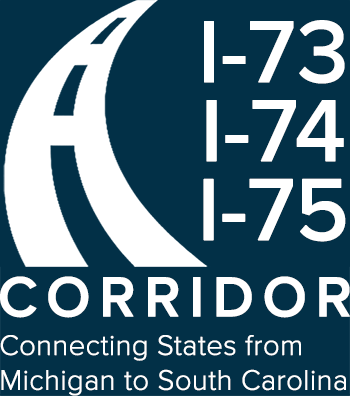Stay Informed with the Latest Developments on I-73/74/75
Explore the progress and milestones of the I-73/74/75 Corridor Association as we connect states, grow communities, and build the future. Stay updated with our chronological timeline and access past announcements through our video gallery.
Project Timeline
Discover the key events that have shaped the I-73/74/75 Corridor Association’s journey.
2021
Momentum Renewed
Governor Henry McMaster announced plans to expand I-73. A federal judge dismissed the Coastal Conservation League’s lawsuit, allowing the project to move forward. Surveys confirmed strong statewide voter support for I-73.
2020
Leadership Transition
Following the retirement of Rep. Alan Clemmons, S.C. Rep. Case Brittain was elected Chairman of the National I-73/74/75 Corridor Association.
2018
Legal Challenges
The Coastal Conservation League filed a lawsuit to block construction of I-73. Economists and community leaders publicly opposed the suit and defended the approved route.
2017
Federal Permit Granted
The U.S. Army Corps of Engineers issued the federal permit authorizing construction of I-73 to begin.
2010
I-75 Joins the Corridor
During the Fall Road Rally in Washington, D.C., Chairman Alan Clemmons announced the inclusion of Interstate 75 in the corridor association—linking shared interests across Michigan, Ohio, and beyond.
2007
National Association Reforms
The National I-73/74 Corridor Association was officially reestablished in Myrtle Beach, S.C. Representative Alan Clemmons was elected Chairman and Brad Dean named President and Executive Director. The reformation was celebrated at a luncheon hosted by U.S. Senator Lindsey Graham and U.S. Secretary of Transportation Mary Peters.
2006
Rebuilding a National Effort
Myrtle Beach Area Chamber of Commerce President & CEO Brad Dean led efforts to revive the National I-73/74 Corridor Association with support from the South Carolina I-73 Association.
1999
State Leadership Takes Over
The umbrella I-73/74 Corridor Association disbanded, transferring leadership and mission back to individual state organizations.
1998
Congress Approves the I-73/74 Corridor
Congress passed the Transportation Bill, signed by President Bill Clinton, which included funding for interchanges in Bluefield and Welch, West Virginia.
1997
10th National Road Rally
The Association hosted its 10th Road Rally in Washington, D.C., marking a decade of coordinated advocacy.
1996
Road Rally in Martinsville, VA
Supporters and officials gathered to sustain progress and expand engagement across the Virginia corridor.
1995
Dual Route Proposal Introduced
At a meeting in Wytheville, VA, the Virginia DOT proposed routing I-73 from Bluefield to Blacksburg, Roanoke, and Martinsville. Association leaders recommended dual I-73 and I-74 routes through Virginia and the Carolinas, later reflected in Congressional highway bills.
1994
Momentum in the Carolinas
The second Road Rally was held in Myrtle Beach, firming up plans and resolving routing issues in Virginia and the Carolinas. The Association gained new state-level support and presented I-73/74 to Congress. By year’s end, both the House and Senate had included the project in major highway legislation.
1993
Association Established
Over 100 business, highway, and political leaders convened in Bluefield, WV for the ISTEA I-73/74 meeting, forming the official I-73/74 Corridor Association. Nelson Walker was appointed Executive Director and state branches were organized.
1992
I-74 Added to the Plan
K.A. Ammar, Mayor Frank Gerlach (Portsmouth, OH), and Ray Cadwadder (Cincinnati, OH) collaborated to include I-74 in the interstate concept, linking Cincinnati to Portsmouth and connecting with I-73.
1990
Interstate Vision Emerges
The Bluefield group expanded efforts beyond U.S. 52, envisioning a continuous interstate—later designated I-73—from Detroit to Myrtle Beach.
1989
Renewed Advocacy
The Greater Bluefield Chamber of Commerce appointed K.A. Ammar, Jr. to lead the campaign to modernize U.S. 52. Thousands of letters, meetings, and presentations built growing public and legislative support.
1982
Bond Issue Proposed
The West Virginia Legislature passed a $510 million bond issue to fund construction of a new U.S. 52, but the plan was later withdrawn due to high interest rates.
1981 - 1980
Push for Legislative Action
Regional leaders campaigned for a statewide bond issue to fund the long-needed highway improvements.
1980 - 1979
Public Support Builds
Grassroots meetings and rallies across the U.S. 52 corridor drew over 100,000 signatures and endorsements from civic and business organizations.
1979
The Bluefield to Huntington Association Formed
Supported by the Greater Bluefield Chamber of Commerce, the group organized to advocate for replacing U.S. 52 and to raise public awareness.
1978
Identifying a Regional Need
A chamber-sponsored survey found that upgrading U.S. 52 between Bluefield and Huntington was the single most critical project for Southern West Virginia’s economic growth.
